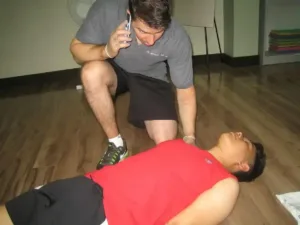Emergency First Aid and cardiopulmonary resuscitation (CPR) courses take approximately 8 hours of class time to complete. This course is typically completed within one full day, however, participants can sometimes opt to complete the course in two, approximately 4 hour, days. Regardless of the provider of the course, whether it be St Mark James, Lifesaving Society or Heart and Stroke Foundation, each provider offers almost identical course outlines. This page offers candidates a quick outline of a emergency first aid course and the approximate time requirements for each component. To successfully complete the course candidates must demonstrate the minimum skill requirement to the instructor and pass the final multiple choice test with a minimum grade of 75%. 100% attendance is mandatory for successful completion of the course.
The following is a course outline of a average emergency first aid and CPR level “A” course (the time component is only a general outline):
-
Participants enrolled in emergency first aid course training will learn basic CPR and AED rescue skills. Principles of First Aid and Legal Implications of first aid – 15 minutes.
- Anatomy and physiology of cardiopulmonary and respiratory system – 5 minutes.
- Personal protective equipment, barrier devices, bystanders and the emergency medical system (EMS) – 15 minutes.
- Unconscious patient assessment – 30 minutes.
- Use and training of a automated external defibrillator (AED) – 15 minutes.
- One rescuer CPR for an adult and obstructed airway treatment for conscious and unconscious adults – 3 hours.
- Conscious patient assessment – 30 minutes.
- Respiratory emergencies including asthma, hyperventilation, anaphylaxis (allergic reactions), and aspiration. – 45 minutes.
- Circulatory emergencies such as shock, major bleeding, heart attacks, transient ischemic attacks (TIA), angina and strokes – 1 hour.
- Injury management including facial injuries and burns – 15 minutes.
- Incident response – 5 minutes.
- Rescue simulations and scenarios – 1 hour.
Health Canada regulations state that the course must be at least 8 hours. Candidates that want to renew emergency first aid and CPR certification can take a refresher course which is shorter and costs less than a full course. Maximum candidate to instructor ratio for a emergency first aid course, as set by St Mark James is 1 instructor per 18 students. Participants enrolled in emergency first aid will learn first aid, CPR and the use of a AED on a adult and child manikins with lungs. Candidates will also practise using barrier devices, epinephrine auto-injector trainers and mock first aid kits. Register for a emergency first aid and CPR course today and learn the best of the basics in first aid and CPR.
